#Igor Kurchatov
Explore tagged Tumblr posts
Text

Igor V. Kurchatov
@fuerst-von-argot
2 notes
·
View notes
Text
#Niels Bohr#Stephen Hawking#Robert Oppenheimer#Wolfgang Pauli#Werner Heisenberg#Richard Fineman#Isaac Newton#Ernest Rutherford#Igor Kurchatov#Paul Dirac#my dead physicist boyfriends
70 notes
·
View notes
Text
Round 1.2: Oganesson (118) vs. Rutherfordium (104)
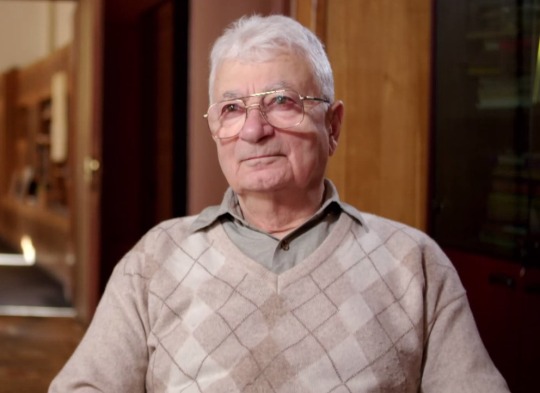
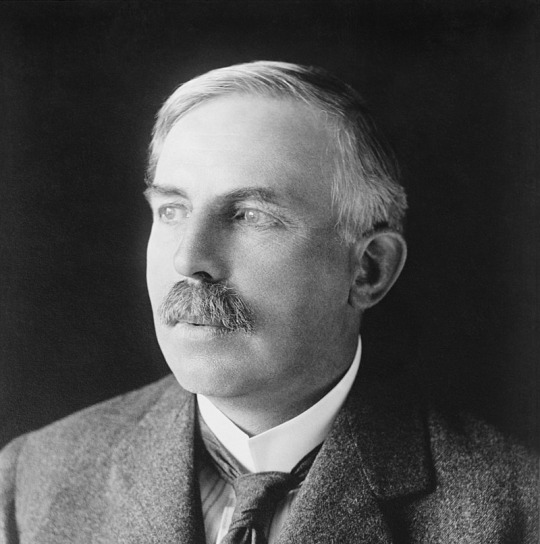
Oganesson (118)
Oganesson is an extremely radioactive, short-lived, superheavy element named for the still living nuclear physicist, Yuri Oganessian. A synthetic element, it has the highest atomic number of any discovered element and is technically a noble gas. With no research done on actual samples due to difficulty of production (only 6 or 7 atoms total ever), researchers still dispute whether it would be a solid or a gas in standard conditions, although solid appears to be the current consensus.
Rutherfordium (104)
Rutherfordium is a radioactive, short-lived, superheavy element named for the so-called father of nuclear physics, Ernest Rutherford. Most likely acting as a heavier homolog to Hafnium, Rutherfordium has had little research done on it.
pick an old man to fuck
#fuckable elements poll#oganesson#rutherfordium#ernest rutherford#yuri oganessian#which old man do YOU want to fuck?#I love reading about the naming controversies related to the superheavy elements#We could have had Kurchatovium#and Igor Kurchatov is something to look at
5 notes
·
View notes
Text

«An engineer (R) works inside of the nuclear reactor scientific research section while another watches him at Igor Kurchatov Science Institute, in Moscow on September 29, 1994.» Photo by Vladimir Velengurin
6 notes
·
View notes
Text
The Heavens declared the glory of the Bomb, and the firmament showeth His handiwork.

He descendeth from the outermost part of Heaven and there is nothing hid from the heat thereof. There is neither speech, nor language, yet His voice is heard among them.
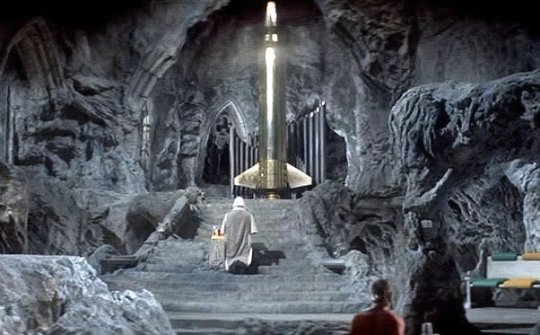
Glory be to the Bomb, and to the Holy Fallout. As it was in the beginning, is now, and ever shall be. World without end. Amen.
“The head of the Russian Orthodox Church, Patriarch Kirill, has said that his country's nuclear weapons saved the nation.
Kirill, who has justified Russian President Vladimir Putin's decision to invade Ukraine in February 2022 on spiritual and ideological grounds, made the remarks on October 18 as he presented a Church honor to physicist Radiy Ilkaev, an honorary scientific director of Russia's Federal Nuclear Center in the town of Sarov.
(…)
Russia's nuclear weapons were created under "ineffable divine providence," Kirill said.
"Were it not for the work of [Soviet atomic bomb creator Igor] Kurchatov and his colleagues, it is difficult to say if our country would still exist," he said.
Soviet scientists "created weapons under the protection of St. Seraphim of Sarov because, by the ineffable providence of God, these weapons were created in the monastery of St. Seraphim," Kirill said. "Thanks to this power, Russia has remained independent and free, and, of course, we must all cherish this remarkable feat of our scientists, who practically saved the country, in our hearts and memories."
(…)
Kirill has justified Putin's decision to invade Ukraine by saying Russia is a "peace-loving power" that does not engage in "military adventures."
In June 2022, he said that Russia was being attacked all over the world because of feelings of jealousy, envy and indignation, adding that he believed this was happening because Russia is "different."” - Putin's Top Priest Says Nuclear Weapons Are 'Divine Providence'
#russia#russian orthodox#kirill#patriarch#nuclear weapons#atomic bomb#soviet#planet of the apes#beneath the planet of the apes#alpha omega#wwiii#world war 3#ukraine#russia ukraine war#vladimir putin#putin
7 notes
·
View notes
Text
Patriarch Kirill, the head of the Russian Orthodox Church, said Wednesday that Russia’s nuclear weapons, which were developed in the town of Sarov, have allowed the country to remain free and independent. He made the remarks while awarding the Order of Sergius of Radonezh to physicist Radiy Ilkayev, an honorary scientific director of Russia’s Federal Nuclear Center.
Mr. Ilkayev, I would confidently say, is a great Russian scientist. He leads the nuclear center, the very one that was created by [physicist and Soviet nuclear bomb project director Igor] Kurchatov. If it hadn’t been for the work of Kurchatov, Mr. Ilkayev, and their colleagues, it’s difficult to say whether our country would exist today. They created the weapon under the protection of Saint Seraphim of Sarov because, by ineffable divine providence, this weapon was created in the monastery of Saint Seraphim. Thanks to this power, Russia has remained independent and free, and, of course, we must all cherish this remarkable feat of our scientists, who practically saved the country, in our hearts and memories.
1 note
·
View note
Text
Cómo el misil de crucero nuclear ruso Stormbringer puede arruinar la máquina de guerra estadounidense
Dmitry Kornev, creador del portal MilitaryRussia.ru, dijo que el misil de crucero nuclear ruso llamado "Burevestnik", que se traduce como "Stormbringer", puede llevar a la quiebra la maquinaria de guerra estadounidense.

Según el presidente Putin, se probó con éxito el “Burevestnik” (“Stormbringer”), un misil de crucero ruso con capacidad y propulsión nuclear que no se parece a ningún otro del arsenal de ningún otro país. ¿Qué se sabe hasta ahora sobre el arma? ¿Qué efecto tendrá sobre el equilibrio estratégico en todo el mundo? Sputnik se puso en contacto con un reconocido especialista para obtener más información.
El Burevestnik, un misil de crucero de largo alcance con un sistema de propulsión nuclear, ha sido sometido a su prueba exitosa más reciente, dijo el jueves el presidente ruso Vladimir Putin ante la audiencia del Club de Debate Valdai en Sochi.
En referencia a su discurso de marzo de 2018 ante los legisladores, durante el cual el presidente dio a conocer el Burevestnik y otras nuevas armas estratégicas destinadas a garantizar la estabilidad estratégica global frente a las medidas estadounidenses para rodear a Rusia con defensas antimisiles con capacidades ofensivas y la planificación del Pentágono destinada a neutralizar el Putin dijo: “Hoy casi hemos terminado el trabajo sobre los tipos modernos de armas estratégicas que anuncié y de los que hablé hace varios años”.
Putin reafirmó que, según la actual doctrina nuclear rusa, Moscú sólo utilizaría sus armas estratégicas en respuesta a una agresión enemiga, pero añadió que debido a las capacidades de respuesta garantizadas por Rusia, cualquier posible agresor sufriría pérdidas “absolutamente inaceptables”.
¿Qué impulsó el desarrollo del Burevestnik?
El torpedo de propulsión nuclear Poseidon, el vehículo hipersónico de impulso y planeo Avangard, el misil balístico intercontinental Sarmat, el misil hipersónico cuasibalístico lanzado desde el aire Kinzhal y el complejo láser Peresvet se desarrollaron junto con otras armas estratégicas de vanguardia. El Burevestnik es parte de la respuesta multifacética de Rusia a la decisión de la administración Bush de retirarse en 2002 del Tratado de Misiles Antibalísticos de 1972.
Rusia desempolvó planos y prototipos de sofisticados sistemas e ideas aeroespaciales y de cohetes que se crearon en estricto secreto a lo largo de la segunda mitad del siglo XX hasta el final de la Guerra Fría como resultado de la decisión miope de Washington. En el caso del Burevestnik, esto implicó construir un motor de cohete térmico nuclear utilizando propulsor de hidrógeno líquido siguiendo un camino establecido por la Oficina de Diseño de Automática Química con sede en Voronezh.
La idea de un motor de propulsión nuclear se desarrolló a finales de la década de 1940, al inicio de los programas nucleares y de cohetes soviéticos, con el apoyo del legendario científico espacial Vitaly Ievlev, Igor Kurchatov, el inventor de la bomba atómica soviética, y el científico espacial Sergey Korolev y Mstislav Keldysh, quienes trabajaron en investigaciones teóricas para desarrollar dicho motor. El estado vio rápidamente el enorme potencial de la idea de que las naves espaciales utilizaran un motor de propulsión nuclear para realizar viajes de larga distancia a través del sistema solar, incluido Marte, pero el trabajo en el programa se concentró primero por completo en posibles usos militares.

De izquierda a derecha: los físicos y científicos de cohetes soviéticos Mstislav Keldysh, Alexander Leipunskiy, Vitaly Ievlev, Igor Kurchatov, Anatoly Alexandrov y Yuri Treskin, 1959.
El RD-0410, el primer y único motor de cohete de propulsión nuclear construido en la URSS, fue finalmente posible gracias al trabajo de Ievlev y su equipo. El proyecto se inició en 1966 en el Centro de Investigación Keldysh. Entre mediados y finales de la década de 1970 se llevaron a cabo allí numerosas pruebas exitosas. A mediados de la década de 1980 se había alcanzado una capacidad de generación de energía de hasta 63 megavatios. Sin embargo, en 1988, la administración Gorbachev puso fin al avance del proyecto. Ievlev falleció en 1990, dos años después.
Durante el mismo período, los científicos estadounidenses de cohetes lograron sus propios avances significativos en este campo. La NASA y la Comisión de Energía Atómica desarrollaron conjuntamente un diseño conocido como Motor Nuclear para Aplicaciones en Vehículos Cohetes (NERVA), con el motor experimental propulsado por hidrógeno líquido construido y certificado. Sin embargo, en 1973, mientras Washington estaba cerrando el programa espacial estadounidense tras los alunizajes, la administración de Richard Nixon decidió descartar el diseño.
Se pretendía que el motor de cohete soviético de propulsión nuclear fuera capaz de producir hasta 196 megavatios de energía utilizando 37 conjuntos combustibles diferentes. También fue impulsado por hidrógeno líquido, con heptano actuando como fuente de energía de respaldo. Sin embargo, ni los diseños estadounidenses ni los soviéticos permitirían que los cohetes o las naves espaciales funcionaran de forma continua durante largos períodos de tiempo; El tiempo de combustión del NERVA fue de aproximadamente 45 minutos y requirió 24 reinicios, mientras que el tiempo de combustión del RD-0410 requirió 60 minutos y 10 reinicios.
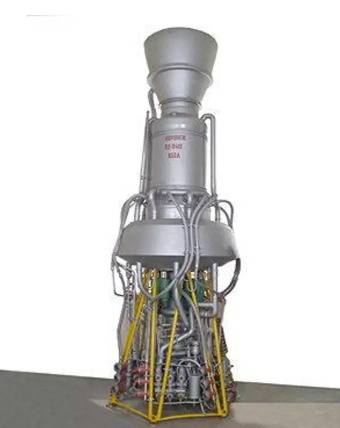
Motor cohete de propulsión nuclear RD-0410.
¿Qué es el Burevestnik?
Con su planta de energía nuclear a bordo construida para proporcionarle energía continua mientras opera dentro de la atmósfera de la Tierra durante días, semanas o incluso meses seguidos, el misil de crucero 9M730 Burevestnik (nombre de informe de la OTAN SSC-X-9 Skyfall) es único. Esto le da al arma un alcance esencialmente ilimitado.
En diciembre de 2001, poco después de que Estados Unidos revelara su intención de abandonar el Tratado ABM, comenzaron los trabajos de desarrollo del Burevestnik. El apodo del posible misil de crucero, "Burevestnik", que se traduce como "Stormbringer", "profeta de una tormenta" o "petrel" en ruso, fue elegido en una votación pública en línea por el Ministerio de Defensa ruso en 2018, unas semanas después. su existencia se hizo pública.
Las dimensiones del Burevestnik parecen ser más o menos similares a las de la serie Kh-101 de misiles de crucero de ultra largo alcance, aunque el Burevestnik parece ser hasta dos veces más grande, según imágenes militares del arma dadas a conocer al público. Sin embargo, la mayoría de las especificaciones del Burevestnik, incluida su carga útil, todavía están clasificadas. Otra diferencia es que, a diferencia del Kh-101, las alas del misil de crucero se ven claramente colgando sobre la parte superior del fuselaje.
Se dice que el Burevestnik tiene un motor nuclear de respiración aérea (ramjet) o turborreactor para la propulsión de vuelo y un motor de arranque alimentado con propulsor sólido. La longitud del misil es de unos 12 metros cuando se lanza, pero disminuye a 9 metros a medida que vuela cuando el motor de arranque se apaga.
La historia y las características de las pequeñas instalaciones nucleares de Burevestnik tampoco se conocen en gran medida. Tanto el Burevestnik como el Poseidon utilizan modificaciones de la misma central eléctrica, según una fuente que habló con los medios rusos poco después del discurso de Putin en marzo de 2018 en el que presentó el arma. La fuente también insinuó que los científicos habían terminado de probar una planta de energía que podría usarse en misiles de crucero y vehículos submarinos autónomos en alta mar.
El Burevestnik ha sido sometido a pruebas en el archipiélago de Novaya Zemlya, en el norte de Rusia. Las pruebas de campo del motor finalizaron en enero de 2019. Ya en junio de 2016, se informó que se estaban realizando pruebas adicionales y se espera que hasta ahora se hayan realizado al menos una docena de lanzamientos, el más reciente de los cuales tuvo lugar en agosto de 2023.
youtube
La OTAN hace sonar la alarma
"Esto le dará a Rusia capacidad para tomar un arma potencialmente nuclear de bajo alcance y luego usarla para hacerla viajar una distancia mayor, decenas de miles de millas", dijo el jueves el mayor retirado del ejército estadounidense Mike Lyons a los medios estadounidenses, varias veces. Horas después del discurso de Valdai de Putin.
“Este misil Burevestnik es normalmente un misil de crucero convencional que se utiliza, digamos, entre teatros. Sin embargo, esto proporciona una visión estratégica. Digamos que tienen esto en el Ártico, donde lo están probando ahora mismo. Podrían lanzar fácilmente este misil desde esa plataforma y alcanzar objetivos en Estados Unidos, sin utilizar misiles balísticos intercontinentales”, explicó Lyons.
En 2020, el entonces jefe de Inteligencia de Defensa del Reino Unido, el teniente general Jim Hockenhull, advirtió que el Burevestnik tiene lo que es efectivamente un “alcance global y permitiría ataques desde direcciones inesperadas”, dando a Moscú un arma con un “tiempo de merodeo casi infinito”. Combinado con las capacidades del Poseidón, esto “permitiría a los rusos mantener la infraestructura civil y militar del Reino Unido y sus aliados en riesgo de ataques directos con explosivos convencionales y armas nucleares, limitando las opciones o aumentando los riesgos en tiempos de crisis”. ”, dijo Hockenhull.
El Burevestnik es un misil de crucero, por lo que debería poder replicar la capacidad de los misiles de crucero existentes para volar a altitudes tan bajas como 50 a 100 metros, obviando efectivamente la necesidad de detección por radar enemigo y limitando la detección a satélites y solo durante el lanzamiento.
Desde el debut de la publicación en 2018, Dmitry Kornev, el creador del portal MilitaryRussia.ru, ha seguido el avance del Burevestnik.
El principal atractivo del misil de crucero como arma de represalia de uso general es su alcance casi infinito, que se mide en “días, semanas o meses”, según Kornev.
“Esto significa que dichos misiles pueden lanzarse y permanecer en vuelo sobre una zona de retención durante varios meses, y pueden alterar estas zonas a voluntad. En este estado, sería extremadamente difícil atraparlos y destruirlos. Por el momento no existen sistemas que puedan detectar de forma fiable estos misiles en sus zonas de almacenamiento y destruirlos. Y en el caso de la 'hora X', si se recibiera una orden que proporcionara información sobre los objetivos… estos misiles podrían avanzar hacia sus objetivos y atacarlos”, explicó el observador.
Dados los recientes esfuerzos de Estados Unidos por neutralizar otros componentes de la tríada nuclear rusa, las inigualables características de alcance del Burevestnik permitirán que el misil maniobre fácilmente alrededor de los sistemas de defensa aérea y avance hacia objetivos “desde una dirección completamente inesperada”. Como resultado, el misil será una nueva y valiosa incorporación a la capacidad de disuasión estratégica de Moscú.
El Burevestnik se diferencia de un misil balístico convencional en que tiene un alcance extremadamente largo y es maniobrable, lo que lo hace más difícil de interceptar, según Kornev. En términos generales, los misiles de crucero "pueden realizar maniobras, doblarse alrededor del terreno, rodear edificios, estructuras, islas y continentes". En el caso del Burevestnik no hay restricciones en el alcance de vuelo, por lo que puede circunnavegar continentes enteros, océanos enteros e incluso el mundo entero en su camino hacia su objetivo.
"Este es un componente completamente nuevo de nuestra fuerza de disuasión nuclear", enfatizó el observador, diciendo que efectivamente ayudará a convertir la tríada nuclear rusa de misiles lanzados desde tierra, aire y submarinos en un cuarteto.
Poderosa carta triunfal para el control de armas
Una vez finalizados el desarrollo y las pruebas del Burevestnik, Moscú tendrá una opción, dice Kornev: poner el sistema en funcionamiento o utilizarlo como moneda de cambio en las conversaciones sobre armas con Washington. “Este asunto aún está en debate. En otras palabras, nadie predice el lanzamiento y empleo de los misiles de crucero Burevestnik mañana. Sin embargo, basándose en este avance, se podría producir rápidamente un sistema de armas que nadie más en el mundo posee.
“Los sistemas que ofrecen represalias garantizadas esencialmente ponen fin a la tradicional carrera armamentista de sistemas de armas nucleares estratégicas”, dice Kornev. Según el observador, la posesión por parte de Rusia de armas como el Burevesink y el Poseidon podría obligar a los Estados Unidos y a otras grandes potencias nucleares a sentarse a la mesa de negociaciones y poner fin finalmente a una situación iniciada por Washington hace más de 20 años, en la que no había Ya casi no quedan acuerdos para garantizar un control efectivo de armas entre las superpotencias nucleares.
"Por supuesto, Estados Unidos trabajará para descubrir cómo contrarrestar al Burevestnik", dijo Kornev. Si se determina que el programa ruso de misiles de crucero de propulsión nuclear ha tenido éxito, “debemos entender que las capacidades financieras y tecnológicas de Estados Unidos son tales que, si así lo desean, podrán ponerse al día”.
¿Podría Burevestnik contribuir a la quiebra del Pentágono? El observador subrayó que el Pentágono actualmente carece de medios para frustrar al Burevestnik. Sin duda reforzarán sus defensas aéreas. Sin embargo, no será una garantía de que estos misiles no encuentren sus objetivos previstos.
“Es probable que Estados Unidos decida crear medios espaciales para detectar tales misiles. Si se sabe dónde vuelan tales misiles, cualquier avión de combate podrá derribarlos… Pero entonces sería necesario crear un sistema de detección, construir un sistema para la transmisión de información, modernizar radicalmente todo el sistema aéreo. sistema de defensa de América del Norte, probablemente Europa y otros países amenazados por tal sistema de armas. En cualquier caso, estos son costos colosales. Y es muy posible que estos costos excedan significativamente el costo de crear misiles del tipo Burevestnik”, subrayó Kornev.
Cuestiones por resolver
Según el experto militar, “quedan muchas preguntas” sobre la utilidad de los misiles de crucero de propulsión nuclear. “¿Rusia creará un sistema de armas sobre la base del Burevestnik? Porque una cosa es la capacidad de lanzar un misil, pero otra es crear un sistema de armas, entrenar personal, producir estos misiles, aceptarlos y operarlos”, señaló Kornev.
Kornev cree que hay muchos problemas que deberán resolverse, empezando por el hecho de que los misiles de crucero no pueden aterrizar de forma segura sin ser destruidos. “Este cohete podría caer y destruirse incluso mientras está siendo probado. En cualquier escenario, los elementos a bordo tienen el potencial de contaminar radiactivamente, dijo.
Otro problema es que el Burevestnik es el primer sistema de este tipo en todo el mundo.
“No tenemos experiencia, no hay experiencia en ningún lugar del mundo; aquí estaremos “en primera línea”, por así decirlo, y es en esa primera línea donde a menudo “llegan” los problemas. Así que, por supuesto, existen ciertos riesgos. Pero si abordamos esta cuestión de manera reflexiva, cuidadosa y utilizando todo nuestro potencial científico, seguramente podremos crear algo único”, resumió el observador.
Sheila Weir tomó fotografías del submarino Vanguard cuando llega a casa, luciendo como un monstruo marino completamente cubierto de algas.
1 note
·
View note
Text
Below I post my translation of an interview with Valery Legasov, originally published in the Izvestia newspaper in 1987.
Science does not tolerate loneliness
He is known not only in our country. According to the results of the traditional contest "Person of the Year" held in the West, Valery Legasov entered the top ten most famous, outstanding personalities, in the category of those people who were in the center of attention of the world community. Of course, the Chernobyl tragedy played a special role here, because Academician Legasov took an active part in eliminating its consequences.
Our correspondent met with the laureate of the State and Lenin Prizes, the first deputy director of the I. V. Kurchatov Institute of Atomic Energy, academician V. LEGASOV.
- Who are you by profession - a reactor engineer, power engineer, physicist, chemist? After all, your interests extend to different fields of science.
No, I'm not a reactor engineer, I work in the field of technologies that provide nuclear reactors. The reactors themselves are not part of my responsibilities. By profession - a physical chemist, I graduated from the Mendeleev Institute, Faculty of physico-chemical Engineering, - it was once created by Igor Vasilyevich Kurchatov. They trained specialists who could separate isotopes, work with radioactive substances, and know the intricacies of nuclear processes.
- What goals did you set for yourself when you decided to do science, or did you not have specific goals, did you not think about it?
- Almost all students, graduating from our faculty, knew that they would go to work in research institutes. We were being prepared for scientific activity. In future scientific work, we imagined life not only as the development of previously achieved. All our thoughts were occupied with one thing - we must definitely set the bar higher, at least one step higher than what was previously mastered. That’s how we were raised. This was our banner. I follow the fate of my comrades: they work in different places, some in science, some in production ... We stay true to our thoughts.
Now I am the head of the Department of Molecular Physics at the Kurchatov Institute. By the way, it was here that I came to do my thesis as a student. And a few years later, I returned as a graduate student.
- After the Chernobyl events, we tried to contact you more than once. It was almost impossible. How long did you stay at the accident site in total?
- I arrived at the NPP already on April 26 in the evening. The main work on the localization of the accident has begun. By May 6, the situation was more or less clear. The main decisions have been made. Then, as needed, I came to the plant not just once. In short, I was splitting time between two homes. How much in total? You know, I didn't count. A lot of…
- What exactly did you do in Chernobyl? What are your reflections on what happened?
- The NPP needed specialists who knew nuclear processes well. I didn't do anything heroic there. All actions were collective. All the suggestions made had to be scientifically justified in order to prevent wrong decisions ... And there is a part of my work in what has been done. But - only a part.
Now about the reflections. I was prepared for serious accidents. A few years ago, I was assigned to head the group of the so-called general industrial safety in the GKNT (State Committee on Science and Technology) of the USSR. Due to my professional interests, I was engaged in the problem of potential dangers from various types of energy. We considered the technological system as a whole, identified the most vulnerable parts. It was concluded that serious industrial accidents are brewing all over the world, a qualitatively new situation has arisen – the capacities concentrated on one site have sharply increased, often given "into the hands" of one operator. The events in our country and abroad have shown that the fears were not in vain. But for me it was a complete surprise: the accident occurred where, in general, it was least expected – at the nuclear power plant. It seemed unlikely. Let's remember: how many wrong actions had to be consistently committed in order for this to happen.
A man, armed with powerful technical means, has just begun to think about how to protect himself from them. Now we need to fight not against something that has already exploded or will explode unexpectedly tomorrow. It is necessary to realize once and for all: we need to fight for the creation of protective technologies adequate to the power that is given to a person. This is a problem common to the whole world. I am for respect for ergonomics - for the correct, reasonable construction of relations in the "man-machine" system. Chernobyl teaches this.
- What ways do you think the development of nuclear technologies will go further?
- Let's remember: every source of energy brought revolutionary changes. People have mastered the secret of fire to keep warm, to protect themselves from the vagaries of nature. But fire, having appeared as a solution to an energy problem or something like that, then gave technologies for the production of iron and copper. Man replaced wood with coal - this caused an industrial revolution: steam engines, steam locomotives, steamships appeared... Then oil - it "gave birth" to automobiles, aviation, rocket technology. This is how humanity developed. At first, it was looking for some kind of energy source in the name of purely energy tasks, and all this led to a radical change in technology. I think that nuclear energy will definitely open up a new quality to a man.
- What do you consider the most important thing in scientific work, what principles do you follow?
- Probably, it is still important to start properly. I don't know if this can be called a principle. But I believe that starting positions in science, as well as in life, are the most important. It is no coincidence that psychologists and other specialists believe that the first four years after birth are very important for the development of a child. In which area they will bring up an interest, will they guess or not guess the inclinations, will they let him listen to music if he is musical, will they give him a pencil if he has the propensity to draw. So in science, the main positions are the starting ones. Unfortunately, sometimes a lot of things in science begin arbitrarily – it comes from the device (because it exists), from some formal plan, from blind copying of the experience of the predecessor, the traditions of the institute… And only then they begin to figure out whether it was necessary to do this?
- It is believed that only 1-5 percent of scientists are generators of ideas, the rest are defenders of established dogmas in science. How do you feel about such arithmetic? What thoughts do you have about this situation in science?
- I didn't count the percentages. I don't even know how it can be calculated? Although I am familiar with such assessments. My point of view is that science is still a relay race, the passing of the baton. I know a lot of people who could be classified as idea generators. If you want, the idea generator is the last person who tore the finishing tape with his chest. And before him, there were always several people passing the baton. Here’s the situation (I experienced it myself!): a colleague comes to me and says - read this article in this magazine. That's it, he's gone. The article pushes me to some considerations, I express them, and someone puts an experiment. And then - success! And it turns out: someone manages to formulate a "finishing" idea according to the nature of his character, thinking. The relay race? Of course, it is... Yes, I agree, the finisher must have certain abilities, his head (prepared) can formulate a new idea. But science is a collective matter. There could not be a single brilliant composer without those who understand his music, without those who write it themselves. The professional environment feeds the most capable people. They’re not born in isolation. Science does not tolerate loneliness.
- Are you satisfied with the current system of organizing scientific research? Could you share your thoughts?
- Remember the joking expression about how to make a sculpture? Take a stone and cut off the excess. It seems to me that the same thing should be done in science today. The potential of our science is very rich. Why is it not always implemented? Because the necessary and unnecessary are next to each other. What do I mean by that? First of all, formalized relationships. Here, I sign with my own hand, probably, tens of thousands of papers a year that are related to science and have nothing to do with it - justifications, tasks, plans, plans-forecasts and so on, so on… This feeds a huge army of people – they do not just feed, they parasitize! Bureaucracy is deadly for science.
Excessive hierarchy has always been contraindicated for science, it stifles it. Science, like art, does not tolerate intermediate links. It is necessary to get rid of people who interfere with work. Scribbling and formalism have reached such a scale that it is already difficult for science to bear this cross.
And one more thing. Every natural scientist should be very well educated in the humanities. I am deeply convinced of this. Otherwise, a real scientist unwittingly limits his capabilities. Great "technicians» have always stood on the shoulders of our great humanitarians. This is how it should be. But in modern science, this balance is broken. It's dangerous.
- Which of your scientific works do you consider the most successful?
- Apparently, those that have brought the greatest benefit. For example, it was possible to synthesize unusual compounds that did not exist before. They have proved to be very useful in nuclear technologies. I am happy that these studies have been recognized by the scientific community. I was very lucky in the sense that the search results were quickly applied in practice.
- What scientific problems are you currently engaged in or would you like to deal with in the near future?
- I continue to work in my field: the creation of new substances, materials, methods of their production and application. I now consider myself absolutely obliged (after Chernobyl) to deal with the issues of chemical diagnostics. What is it? We want to create sensitive elements that can detect the smallest gas emissions from metals and other materials… These will be early warning sensors. Each construction lives according to its own laws. Something is constantly happening in it, the state of the material is changing. The sensor is designed to keep track of changes and warn about the danger on time.
- Are you interested in what is happening in other branches of knowledge?
- Absolutely. We must not lose the connections between the cells of a single organism. I’d even specially educate people who can and are able to "transfer" information from one area to another. This is a very important question.
- What do you think, in what field of science are we waiting for qualitatively new discoveries?
- My answer will probably be amateurish. You know, it's always easier to expect something outstanding in a field that… you don't know. I think more complex materials, processes, and technologies will appear. They will be based on biologically active components. But this is not bionics, not biotechnology, but something brand new, living not according to the laws of physics and chemistry, but biology, capable of exchanging information, restructuring, possessing memory…I dare to think that there will be a technique that works on the principles of biosystems.
- You have many students. At Moscow State University, you even organized "your" special group. How do you want to see them?
- I want them to understand, to realize the main thing - their purpose. Once a person was born, whom the world did not yet know, he must definitely leave behind something that did not exist before him - let it be a comma, a little dot, but his own!
Interviewed by G. Alimov
@elenatria @connihd @alyeen1 @litttlesilkworm @odense @owlboxes @valerafan2 @valerij-aleksejevic-legasov @foreverflowercore @4everflowercore @drunkardonjunkyard @natasharedfox @ignalina-c0re @lastnightfanfictionsavedmylife @art-is-a-malady @arthoe3105 @borislegasov @the-jewish-marxist @johnlockismyreligion @tryingtobealwaystrying @hiboudecheshire @soviet-history-detective @kylos-scarf @bewareofdragon
#my translation#valery legasov#valerylegasov#35 years of chernobyl#chernobyl fandom#chernobyl disaster#Chernobyl#��алерий легасов#chernobyl npp#чернобыль#chernobyl#интервью#interview#чернобыльская аэс#чернобыльская катастрофа
72 notes
·
View notes
Text
Dude Spotting Guide for Chernobyl HBO
A guide to spotting all the dudes and like three dudettes, cause there’s only so many white guys in white overalls that you can remember at any given time lol
It has too many details. Yell if you spotted a dude you want on here and i’ll add them or something @sunset-and-periwinkle @owlboxes @borislegasov @natasharedfox @litttlesilkworm @shark-from-the-park @stellan-pip-69 @seaweednpeanuts @kylos-scarf idk who else requested it, tag everyone, we need electricians we need mechanics we need bodies
NPP STAFF:
Akimov, Aleksandr Fyodorovich, shift foreman of the fifth shift in Unit 4 (32):

Brazhnik, Vyacheslav Stepanovich, senior turbine machinist operator (28):


(he’s such a background character it’s hard to get pics of him lol) Bryukhanov, Viktor Petrovich, plant director (51):

Degtyarenko, Viktor Mikhailovich, reactor operator (31):
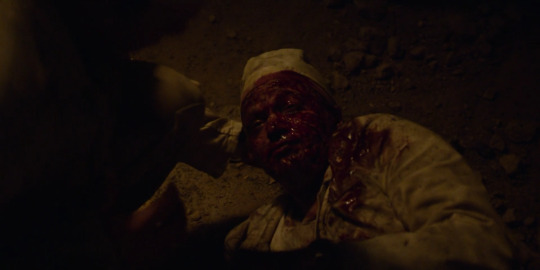
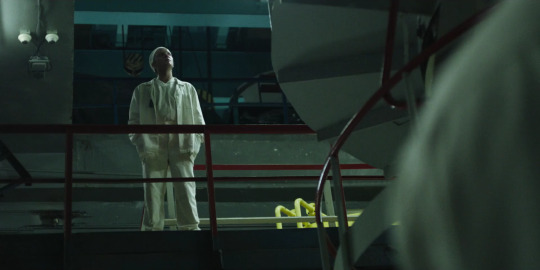
Dyatlov, Anatoly Stepanovich, deputy chief engineer of phase two (55):

Gorbachenko, Nikolai Fedorovich, dosimetrist on duty (?):

Fomin, Nikolai M., chief engineer (50) (jesus fuck i know i read his patronymic somewhere but i can’t find it now and it’s bugging the hell out of me help):

(it’s Nikolai Mweaselyfucker Fomin, and i don’t know when he was born but i’m 98% sure he’s a pisces, this is the kind of shit one of us would pull)
Khodemchuk, Valery Ilyich, senior main circulating pump operator (35):
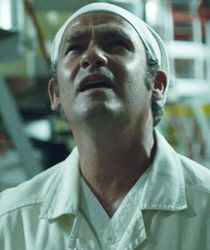

Kirschenbaum, Igor, senior turbine control engineer (27):
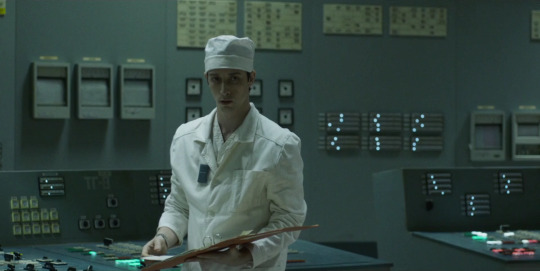
Kudryavstev, Aleksandr Gennadiyevich, trainee senior reactor control engineer (28):

Perevozchenko, Valery Ivanovich, reactor section foreman (38):
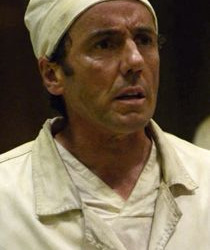
Proskuryakov, Viktor Vasilyevich, trainee senior reactor control engineer (31):

Sitnikov, Anatoly Andreyevich, deputy chief operational engineer (46):

Stolyarchuk, Boris Vasiliyevich, senior unit control engineer (late 20s):

Toptunov, Leonid Feydorovich, senior reactor control engineer (26):

Yuvchenko, Aleksandr, senior mechanical engineer (24):

PRIPYAT:
Ignatenko, Lyudmilla, loving wife (23):

Ignatenko, Vasily Ivanovich, firefighter (25):

Pravik, Volodomyr Pavlovich, firefighter (liutenant) (23):


Misha, Meesha, firefighter (23) (no he isn’t):

Oksana, exposition device (30):

Mikhail, cleans floors at a train station (prolly also 30):

Baby, tragedy (baby):

Zinchenko, Svetlana, doctor (25):

Zharkov, personification of The Bad System (old enough to shut the fuck up):
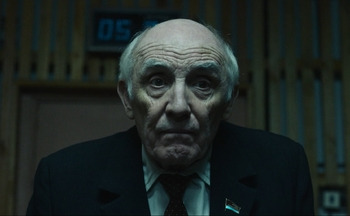
Petrov, voice of sanity (30):

Kirill Yuvchenko, future doctor, current toothless kid (2):

LIQUIDATION:
Legasov, Valery Alekseyevich, deputy director of the Kurchatov Institute of Atomic Energy (50):
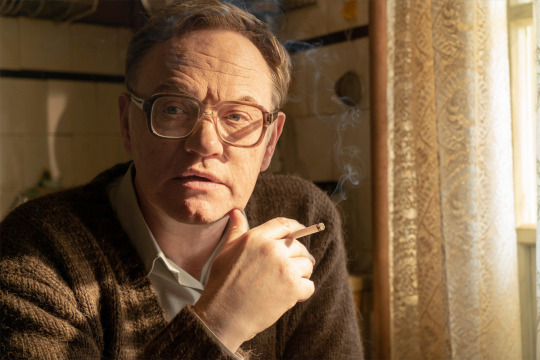
Scherbina, Boris Yevdokimovich, vice-chairman of the Council of Ministers, (67):

Khomyuk, Ulana Yuriyvna, chief physicist of the Byelarusian Institute for Nuclear Energy (40s):

Pikalov, Vladimir Karpovich, general, commander of the Chemical Troops of the USSR (62):
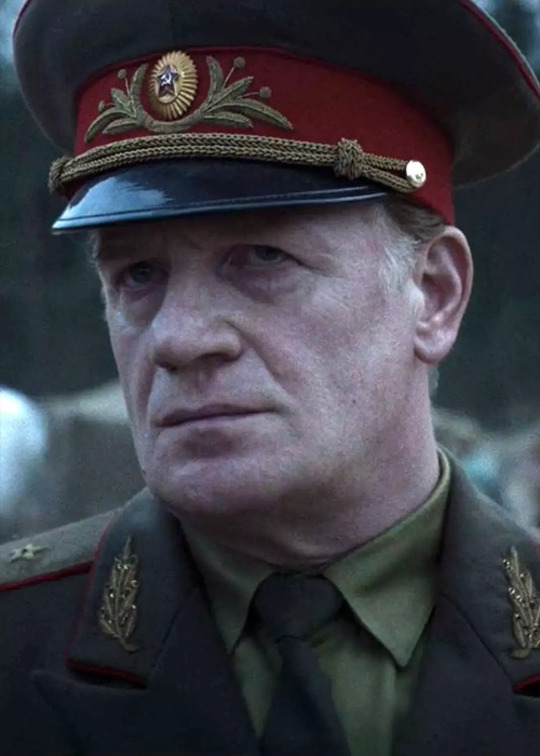
Tarakanov, Nikolai Dmitrievich, general, Soviet military leader, motivational speaker and sex symbol (script says 45, but actually he was 52):

Ananenko, Oleksii, mechanical engineer (27):
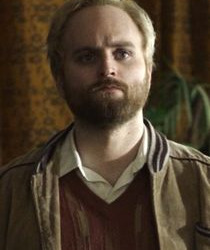
Bezpalov, Valery, senior engineer (script says 40? i think? truth to be told we don’t even seem to know how his name is spelled. is it a Bezpalov or Bespalov? who are you dude?):

(actually i think it should be Bespalov, jsyk)
Baranov, Boris, shift supervisor (46):

Glukhov, Andrei, mining crew chief (40):

Jughashvili, robot operator (probably too young):

Gremov/Yefremov , Pavel Ivanovich/Miklailovich , conscript, animal control (23):

(i grabbed his full name off of fcken tvtropes lol) (other name version as heard by @litttlesilkworm
Bacho, Afghanistan veteran, animal control (vodka dad) (36):
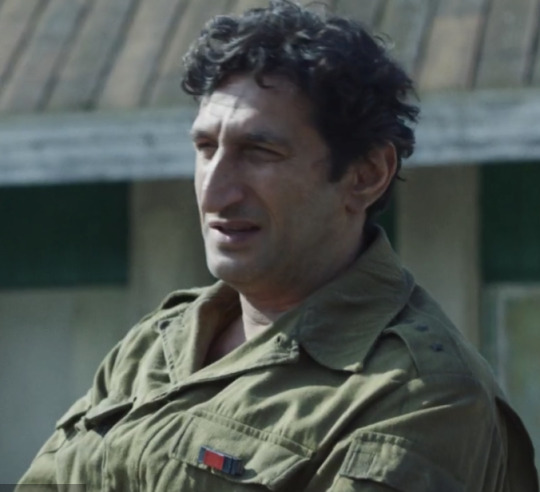
Garo, Afghanistan veteran, animal control (30):

Janek, not Latvian, Estonian (25):

POLITICS:
Gorbachev, Mikhail Sergeyevich, General Secretary of the Communist Party of the Soviet Union (55)

Charkov, Aleksandr, KGB first deputy chairman, (63):

Shadov, Mikhail, Minister of Coal Industries (40s)
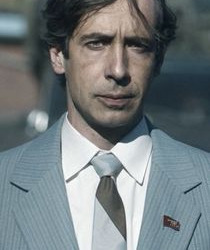
Garanin, worked in a shoe factory, now in charge (57, overfed):

Chulkov, poet, timewaster (50s):
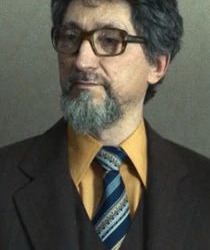
Stepashin, Andrei, state prosecutor (50):

Kadnikov, Milan, judge (55) (no he isn’t):

OTHER DUDES AND DUDETTES TO SPOT:
Dmitri, physicist of the Byelarusian Institute for Nuclear Energy (30):
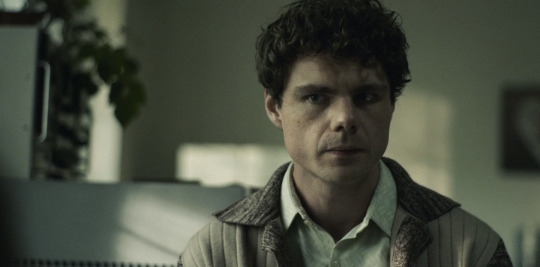
Marina Gruzinskaya, scientist, a smart lady (40s):

Major Burov, he allows it (45):

66 notes
·
View notes
Video
youtube
Ein Mensch bleibt immer ein Mensch und wahrscheinlich bleibt ein Schwein immer ein Schwein! Du verdammtes Schwein!
---
The Tsar Bomba (Russian: Царь-бо́мба), (code name: Ivan or Vanya), was a hydrogen aerial bomb, and the most powerful nuclear weapon ever created and tested. Tsar Bomba was developed in the Soviet Union by a group of nuclear physicists under the leadership of Igor Kurchatov, an academician of the Academy of Sciences of the Soviet Union.
Nikita Khrushchev announced the upcoming tests of a 50-Mt bomb in his opening report at the 22nd Congress of the Communist Party of the Soviet Union on October 17, 1961. Before the official announcement, in a casual conversation, he told an American politician about the bomb, and this information was published on September 8, 1961, in The New York Times. The Tsar Bomba was tested on October 30, 1961.

The mushroom cloud of Tsar Bomba seen from a distance of 161 km (100 mi). The crown of the cloud is 65 km (213,000 ft; 40 mi) high at the time of the picture. (source: Rosatom State Corporation Communications Department 20-08-2020)
1 note
·
View note
Text



Soviet stamps.
1) city of Obninsk
2) Igor Vasilievich Kurchatov - the father of soviet atonic bomb
3) Yury Kharinton - the former chief of soviet nuclear weapons designers.
All the pictures comes from the book titled „Nuclear Russia: The Atom in Russian Politics and Culture” by Paul R. Josephson
@fuerst-von-argot
@elenatria
#chernobyl#chernobyl hbo#valery legasov#scientific research#i will get my phd some day#academic validation#article#bachelors degree#post stamps#european history#ukraine#ussr history#article that is now a bachelor’s thesis
4 notes
·
View notes
Text
Una persona que renuncia a su condición humana es castigada

POR VALENTIN KATASONOV
Traducción de Juan Gabriel Caro Rivera
Karel Čapek advirtió sobre esto hace 100 años
Uno de los rasgos distintivos del siglo XX fue la carrera armamentista que reinó en el mundo. La carrera continúa hoy, pero su enfoque ha cambiado. Hoy en día, lo que está en juego no es tanto el aumento del poder de las armas convencionales y las armas de destrucción masiva como el de la tecnología de la información y la informática, la digitalización de todos los aspectos de la vida humana y la sociedad: finanzas, economía, gobierno, educación, asuntos militares y la vida cotidiana. Las tecnologías de la información y la informática, o tecnologías digitales, se consideran un medio universal por el cual se puede controlar a la población, fortalecer la competitividad internacional de la economía, garantizar la seguridad y desarrollar el poder militar.
Los productos de esta carrera son las monedas digitales, los sistemas para acumular grandes cantidades de información (big data) y muchas cosas “inteligentes” que brindan control en línea sobre los humanos, además de la inteligencia artificial.
La élite mundial (dueña del dinero) impulsa la carrera de las tecnologías digitales de todas las formas posibles, teniendo en cuenta que, en última instancia, se construirá un campo de concentración electrónico mundial a partir de productos separados del progreso científico y tecnológico. Los remanentes de la humanidad serán llevados allí, menos los que serán destruidos, incluso mediante la vacunación masiva y la élite mundial tomará el mando del gobierno mundial. No exagero: estos planes de la élite mundial se conocen de muchas fuentes. Incluidas las obras literarias del género de la distopía [novelas Nosotros (1920) de Evgeny Zamyatin (1), Un mundo feliz (1932) de Aldous Huxley (2), 1984 (1948) de George Orwell (4), 451 grados por Fahrenheit de Ray Bradbury (1953) (5) y otros].
Los autores de estos libros no fueron solo visionarios. Tenían una perspectiva amplia, una mente inquisitiva, intuición y algunos de ellos tenían acceso a información clasificada como "secreta". La mayor parte de lo que se describe en las distopías famosas ya se ha hecho realidad. Por ejemplo, hace 100 años, Yevgeny Zamyatin describió una sociedad totalitaria del futuro lejano, donde las personas no tendrían nombres y en su lugar tendrían identificadores digitales.
Todo lo que veo hoy encaja en los algoritmos para construir un "mundo feliz" descrito en las novelas distópicas. Y queda claro qué es la llamada pandemia de COVID-19. Esta es una cortina de humo organizada por la élite mundial, que está diseñada para ayudar a acelerar la construcción de un campo de concentración electrónico, la destrucción de parte de la población mundial, el colapso de los Estados nacionales y la legalización del gobierno mundial.
Durante el período en que los países estuvieron encadenados por la cuarentena, se tomaron una serie de decisiones que parecen extrañas solo a primera vista. Por ejemplo, la ley sobre la realización de un experimento para desarrollar la inteligencia artificial en Moscú. Se trata de una serie de asignaciones del gobierno y las corporaciones y organizaciones públicas sobre temas relacionados con la información genética. En particular, el director de Rosneft, Igor Sechin, recibió instrucciones de crear y dirigir el Centro de Investigación Genética Integral y de Edición Genética. El Centro Nacional de Investigaciones "Instituto Kurchatov" se encargó de la creación y mantenimiento del funcionamiento del sistema de información y análisis para almacenar y procesar datos genéticos de la "Base Nacional de Información Genética". En el texto de la lista de órdenes, se utiliza el término "tecnologías de la edición del genoma". A principios de junio se aprobó una ley federal sobre la creación de un registro de información unificado con información sobre la población. Cuando estas piezas del "rompecabezas" estén conectadas, veremos el panorama general.

Me centraré en la primera de las iniciativas enumeradas, en relación con la inteligencia artificial (IA). El título completo de la ley: “Sobre la realización de un experimento para establecer una reglamentación especial a fin de crear las condiciones necesarias para el desarrollo y la implementación de tecnologías de la inteligencia artificial en la entidad constitutiva de la Federación de Rusia, la ciudad de importancia federal Moscú, y enmendar los artículos 6 y 10 de la Ley federal sobre datos personales". Ya se ha dicho y escrito mucho sobre los riesgos para los ciudadanos y para todo el país que conlleva la ley de la IA. Las encuestas realizadas por VTSIOM, después de la aprobación de la ley sobre la IA (5), mostraron que aproximadamente la mitad de los representantes comerciales desconfían de la tecnología de IA; el 43% de las empresas encuestadas no utilizan la inteligencia artificial en su trabajo y no tiene previsto hacerlo en un futuro próximo. Un tercio de los encuestados tenía una idea extremadamente vaga de la IA, y el 12% de los encuestados se pronunció directamente en contra de la ley, por temor a consecuencias impredecibles. El jefe del Consejo de Derechos Humanos (CDH), Valery Fadeev, expresó su preocupación por la ley aprobada. El uso de la inteligencia artificial, en su opinión, está plagado de la amenaza de la implantación de chips masivos. El director del CDH destacó dos puntos negativos del sistema de Moscú: una gran cantidad de sensores y cámaras que rastrean el movimiento de los ciudadanos; y que todos los datos se envían a un solo registro federal.
Esto sin mencionar los muchos temores de académicos y especialistas en alta tecnología. Se destaca especialmente la siguiente preocupación: la inteligencia artificial es capaz del autoaprendizaje y lo hace más rápido que los humanos. En otras palabras, el cerebro humano puede no ser competitivo en comparación con la IA.
Hoy en día, el cerebro humano ya es incapaz de calcular las consecuencias de la introducción de la IA para la humanidad. ¿Se puede liberar a un genio de la botella en tal situación? ¿Quizás una persona debería comenzar a restaurar su propia inteligencia y no intentar reemplazarla con una que sea artificial? Tales preguntas comenzaron a surgir en algunas personas mucho antes de que aparecieran las computadoras, el Internet, las redes neuronales y otros atributos del mundo digital.
Me gustaría especialmente llamar su atención sobre el escritor checo Karel Čapek (1890-1938) (6). Merece ser nombrado entre los diez escritores más destacados del siglo XX. Me detendré en su obra escrita hace cien años en 1920: R.U.R. Por cierto, esta no es solo la fecha de creación de una obra literaria conocida, sino también el nacimiento del término "robot". La abreviatura R.U.R. significa Rossum Universal Robots ("robots universales de Rossum").
La obra se desarrolla en una fábrica que produce personas artificiales: robots. La palabra "robot" proviene del idioma eslovaco: robota significa "trabajo duro", "trabajo difícil", "corvea" (la Corvea Real consistía en la obligación de trabajar gratuitamente en las tierras del noble o señor feudal, n.d.t). Los robots de la obra de Čapek son producto de la biotecnología, están formados por diferentes tejidos y órganos cultivados en una fábrica. Parecen humanos.
La historia de los robots comienza con el científico Rossum Sr., quien una vez se propuso refutar la existencia de Dios creando humanos artificiales. Y logró crear un hombre artificial, pero no del todo. Era una criatura que físicamente era casi indistinguible de un humano, pero mentalmente muy por detrás. El anciano solitario trató de discutir con Dios, pero la discusión fue interrumpida por la muerte del rebelde. Rossum Jr. (sobrino de Rossum Sr.) continuó el trabajo de su tío, descartando la alta filosofía: “Es una tontería hacer a un humano durante diez años enteros. Si no comienza a producírselos más rápido que la naturaleza, toda esta empresa debería ser enviada al infierno". El sobrino inició la producción de criaturas humanoides simplificadas en la fábrica para el trabajo físico, no de humanos, sino seres para el "trabajo". Afortunadamente, la demanda de tal fuerza laboral, desprovista de gran inteligencia, deseos y sentimientos, era alta en el mercado.
Como resultado, los humanos se liberaron del trabajo duro y humillante, el uso masivo de robots creó un mundo de abundancia, todos se sumergieron en una atmósfera de bienestar y descuido ilimitados: “Todo es una auténtica orgía loca y bestial. Ahora no estiraremos las manos para comer, meterán la comida en nuestras bocas para que no nos levantemos... Nosotros, pueblo, nosotros, la cima de la creación, no envejecemos por el trabajo, no envejecemos por el parto, no envejecemos por la pobreza. ¡Démonos prisa, démonos prisa, danos todos los placeres del mundo!"
Los seres humanos intoxicados por este pensamiento dejaron de nacer. La población del planeta ha llegado a 8.500 millones de personas, y en este punto se congeló. Y el número de robots siguió creciendo y superó el número de humanos por muchas veces.
Al mismo tiempo, surgió otro fenómeno misterioso e inquietante. Algunos robots han sufrido mutaciones, iniciando un rápido desarrollo mental. Había robots "con alma", "en un millón de buenos y viejos robots, sólo hay uno reformado". Estos individuos no estándares estaban sujetos a la destrucción, pero algunos de los robots "avanzados" continuaron vivos. Estos eran robots que llevaban a cabo un autoaprendizaje. Aprendieron siguiendo el ejemplo de los humanos. Uno de ellos (llamado Damon) argumenta: "¡Tienes que gobernar y matar para ser humano!"
Los robots comenzaron a exigir cada vez más derechos iguales a los humanos, y algunos querían gobernar a los humanos. Comenzaron a crear sus propias organizaciones y llamaron a los robots a luchar contra los humanos: “¡Robots del mundo entero! Nosotros, la primera organización de "Rossum Universal Robots", proclamamos al hombre como enemigo de la naturaleza (!) ¡Y lo declaramos proscrito!" Al final, los robots de todo el mundo se rebelaron. Asediaron la fábrica de Rossum, la tomaron y mataron a todos menos al arquitecto Alquist. Uno de los personajes principales de la obra, Elena Glory, quema los manuscritos de Rossum Sr. que contienen la fórmula para hacer robots.
Al final, todos los seres humanos del planeta quedan destruidas. Los robots le piden a Alquist, el único humano superviviente en la Tierra, que restaure la fórmula, sin la cual es imposible una mayor reproducción de los robots. Sin una fórmula, la fábrica simplemente produce montones de carne y órganos que nadie quiere. Alquist ya es viejo, su búsqueda de una fórmula no da ningún resultado. Pide a los robots que intenten encontrar otros seres humanos vivos en el planeta, pero no lo consiguen. Los robots obtienen una victoria pírrica sobre el hombre.
La obra de Čapek se puede llamarse una distopía escatológica. No expondré más de la obra, vale la pena leerla por uno mismo. Te permite comprender lo que está sucediendo en el mundo de hoy.
Čapek anticipó la aparición de robots en el siglo XX. Incluso predijo el siglo XXI. Los científicos dicen que en una o dos décadas más, la ciencia creará un robot compuesto por tejidos orgánicos. Y en la actualidad, se está trabajando activamente para crear ciborgs, híbridos máquina-humano. La obra puede y debe percibirse como una parábola que es relevante en todo momento.
La principal tragedia de la humanidad ni siquiera es la tecnología. El hombre ya no quiere ser hombre. A los seres humanos les gusta degradarse. ¿Por qué, por ejemplo, debemos necesitar de nuestra propia inteligencia, si esta puede ser reemplazada por una que sea artificial? No se invertirá en la educación, pero aceptará e implementará programas de IA. ¿Por qué deberíamos trabajar si podemos vivir sin trabajar? Los que están en el poder fomentan la degradación del hombre: es más fácil manejar el ganado que al ser humano. Por tanto, se están haciendo esfuerzos para transformar al homo sapiens; se utilizan herramientas como los medios de comunicación, la industria del entretenimiento, la promoción del libertinaje, las drogas. Un robot también puede ser un ser humano.
Y por el rechazo de los seres humano de su condición de ser humanos, ellos serán castigados. Pasan de ser seres humanos razonables y se convierten en otra cosa. Y luego serán completamente destruidos.
Notas:
1. https://www.fondsk.ru/news/2020/06/05/antiutopia-stanovjaschajasja-realnostyu-51052.html
2. https://www.fondsk.ru/news/2020/06/07/o-divnyj-novyj-chelovek-51072.html
3. https://www.fondsk.ru/news/2015/05/01/dvoemyslie-evropy-perechityvaja-oruella-33068.html
4. https://www.fondsk.ru/news/2020/06/25/rej-bredberi-o-tom-kak-szhigajut-pravdu-51217.html
5. https://www.rbc.ru/technology_and_media/07/02/2020/5e3c44b99a7947e1a97fb230
6. https://www.fondsk.ru/news/2020/06/27/eshatologia-karela-chapeka-51236.html
Fuente: https://www.fondsk.ru/news/2020/09/29/chelovek-otkazavshijsja-ot-statusa-cheloveka-nakazyvaetsja-51936.html
2 notes
·
View notes
Photo

SOUND: https://www.ruspeach.com/en/news/9963/ 12 января 1903 года родился Курчатов Игорь Васильевич. Это советский физик, «отец» советской атомной бомбы. Он был основателем и первым директором Института атомной энергии с 1943 по 1960 годы, главным научным руководителем атомной проблемы в СССР, одним из основоположников использования ядерной энергии в мирных целях. кOn January 12, 1903 Kurchatov Igor Vasilyevich was born. This is a Soviet physicist, "father" of the Soviet atomic bomb. He was a founder and the first director of Institute of atomic energy from 1943 to 1960, the chief research supervisor of a nuclear problem in the USSR, one of the founders of uses of nuclear energy for peaceful purposes. физик [fizik] - physicist институт [institut] - institute Игорь [ìgar'] - Igor директор [direktor] - director энергия [ehnergiya] - energy физика [fìzika] - physics руководитель [rukavadìtil'] - head проблема [prablèma] - problem научный [nauchnyj] - scientific главный [glàvnyj] - main www.ruspeach.com
3 notes
·
View notes
Photo



When Atomic Was Sexy (170)
И. В. Курчатов у эксперименталышй уста-новки «Огра»; Институте атомной энергии. 6 февраля 1960 иода (I. V. Kurchatov in the experiment of the Ogra experiment; Atomic Energy Institute. February 6, 1960 Iodine)
Депутат Верховного Совета СССР И. В. Курча-тов среди своих избирателей. Свердловск, 1958 год (Deputy of the Supreme Soviet of the USSR I. V. Kurchatov among his voters. Sverdlovsk, 1958)
Академики Ф. Жолио-Кюри, И. В. Курчатов, Д. В. Скобельцын, Л. А. Арцимович и А. И.Али- ханов (слева направо). Москва, 1958 год (Academicians F. Joliot-Curie, I. V. Kurchatov, D.V. Skobeltsyn, L.A. Artsimovich and A.I.Ali-Khans (from left to right). Moscow, 1958)
Last of the images from a postcard set dedicated to Igor Vasilievich Kurchatov, the Father of the Soviet Atomic Bomb.
Rocket Werks Atomica
3 notes
·
View notes
Photo

Enjoy the Janet Kuypers 12/3/21 poem "Rutherfordium, blinked out of existence", a Twitter-length Periodic Table poem for element #104, Rutherfordium (Rf): The U.S. & Soviets battled in transfermium wars, even to name periodic table elements. For 104, the U.S. said, Ernest Rutherford & nuclear science; Soviets said, Igor Kurchatov & Russian nukes. It's ironic they fought to win, by discovering what quickly blinked out of existence. #janetkuypers #janetkuyperspoem #janetkuypersinstapoem #janetkuyperstwitterverseperiodictablepoem https://www.instagram.com/p/CXCWzjdvhw5/?utm_medium=tumblr
0 notes
Photo

New Post has been published on https://freenews.today/2021/01/20/russia-denies-alleged-plan-for-statues-to-stalins-murderous-secret-police-chief-beria-says-waxworks-part-of-historical-display/
Russia denies alleged plan for statues to Stalin’s murderous secret police chief Beria - says waxworks part of historical display


Lavrentiy Beria is a figure whose name once sparked terror throughout Eastern Europe. As the head of the Soviet Union’s brutal NKVD secret police, he oversaw tens of thousands of executions and deportations to the gulags.
Now, though, the notorious Georgian is at the center of a media row. On Tuesday, a number of Russian news outlets and commenters reported that Rosatom, the state nuclear regulator, was planning to install two statues to the revolutionary in honor of his contribution to the USSR’s atomic weapons program.
According to Open Media, a Russian-language news site controlled by disgraced former oligarch Mikhail Khodorkovsky, officials had commissioned the pair of “highly realistic mannequins” for an exhibition on the history of the Soviet nuclear arsenal. In response to a media inquiry, the department’s press service quoted eminent physicist Igor Kurchatov as saying “if it hadn’t been for Beria, we wouldn’t have had a bomb.” “Therefore,” they conclude, “it is impossible to tell the story of the nuclear project of the USSR without mentioning Beria.”
However, Andrey Cheremisinov, the Director of Communications at Rosatom, which manages public procurement, denied on Tuesday that Beria was being memorialized by the Russian government. “It’s not accurate information,” he said. “There will be no sculptures of Laurence Beria.” However, he caveated that there would, however, be a waxwork installation and “Beria will be one of many.”
Far from being put on a pedestal, the murderous spy chief would only form part of a historical display. Previous displays like this, such as those organized by the famous London-based Madame Tussaud’s, have featured a diverse range of historical characters, including Charlie Chaplin, Chairman Mao and Adolf Hitler.
President Vladimir Putin’s spokesman, Dmitry Peskov, talked up the exhibit during a call with journalists later on Tuesday. “I think it’ll be interesting to many people,” he said.
One of the most influential ministers serving under Communist leader and fellow Georgian Joseph Stalin, Beria shaped the NKVD into a ruthless tool of political control and oversaw the promulgation of a vast network of gulag labor camps. His ruthless organizational skills when it came to prisoner management were, apparently, also invaluable for nuclear engineering, and he oversaw the successful completion of the Soviet atomic bomb project in just under five years.
However, after Stalin’s death in 1953, Beria fell from grace, outmaneuvered by the future Soviet premier Nikita Khruschev. He was tried for treason and executed later that year. Since his death, Beria has come to represent the historical face of the revolution’s most inhumane excesses. British historian Simon Sebag-Montefiore describes how he was personally involved in the interrogation of political prisoners, reportedly placing a snake in the prison cell of a grieving widow and beating her children to death himself.
In 2011, workers digging a ditch near Beria’s former stately home in Moscow discovered a mass grave. Reports have claimed that Beria leveraged his position to sexually entrap young women, murdering any who resisted in his basement then ordering his men to bury them.
Think your friends would be interested? Share this story!
Source
1 note
·
View note